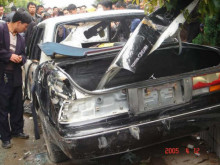 I call the 1980s the “naïve decade”. The cold war was ceasing. The East – West, USSR – USA struggle was ending. The Berlin Wall was tumbling down. No more nuclear arms race. Disarmament talks. Superpower chess game over. Peace at last!
I call the 1980s the “naïve decade”. The cold war was ceasing. The East – West, USSR – USA struggle was ending. The Berlin Wall was tumbling down. No more nuclear arms race. Disarmament talks. Superpower chess game over. Peace at last!
Nothing could be further from the truth. Seething, pent-up animosities between various ethnic groups in countries that were pawns of the superpowers erupted like Vesuvius. Suddenly there were hotspots everywhere, similar to a dry summer wildfire here in British Columbia. Except that these weren’t natural disasters, which can be disastrous but at least have a clear cause and effect. These were clearly human-induced. Complex, with complex solutions.
As an aid worker, I was part of the effort to extinguish these hotspots. First in Ethiopia in the mid 80’s, when Mengistu was still in power and attempting what would come to be known as “ethnic cleansing”. Later in Somalia, working along the Ethiopian border with  ethnic Somali refugees unable to return to Ethiopia. I was there until Somalia unraveled into a ‘stateless’ nation, which it remains. In Rwanda, helping a guilt-ridden US government pick up the pieces after an attempted genocide. Or Liberia, writing likely-to-fail project proposals in a country remaining from early legacy of 1820s US politics, when President Monroe’s slavery solution sent thousands of blacks back to Africa’s west coast, carving out this ironically-named nation. Or Kosovo, originally a territory of multi-ethnic Yugoslavia, the quintessential Soviet satellite state, which became the definition of ethnic slaughter after Tito died without wisdom enough to have a successor in place. I could continue, but I may sink into depression.
ethnic Somali refugees unable to return to Ethiopia. I was there until Somalia unraveled into a ‘stateless’ nation, which it remains. In Rwanda, helping a guilt-ridden US government pick up the pieces after an attempted genocide. Or Liberia, writing likely-to-fail project proposals in a country remaining from early legacy of 1820s US politics, when President Monroe’s slavery solution sent thousands of blacks back to Africa’s west coast, carving out this ironically-named nation. Or Kosovo, originally a territory of multi-ethnic Yugoslavia, the quintessential Soviet satellite state, which became the definition of ethnic slaughter after Tito died without wisdom enough to have a successor in place. I could continue, but I may sink into depression.
The paradox is that my 20-year journey in humanitarian relief began with rural development. However, soon the number of disasters, especially the increase in complex emergencies caused from both internal strife and cross-border conflict, forced Western nations to funnel limited resources into relief efforts. Rural development received a paltry sum. And continues to do so.
As we have all heard, an ounce of prevention is worth a pound of cure. Relief efforts are reactive, short-sighted, and costly. Development is proactive, needed, and less expensive. Unfortunately, there is little political will, and even less money, to apply to development programs in “underdeveloped” countries.
I have sat through too many meetings with diplomats whose role is to unravel an “underdeveloped” country’s political, social, and![13693367913e154-220x175[1]](http://www.emergriskreduction.com/wp-content/uploads/2013/07/13693367913e154-220x1751.jpg) cultural complexities and promote “durable” solutions. The $64 question is how? I revel in only being a emergency management technician, not the one asked to provide the answers. I do believe the focus should be to “develop” these “underdeveloped” nations, and that the answer is not with relief programs, from which massive dependency has be created. There’s a discrete place for relief, but it should not consume aid budgets. Assist these nations with in-country technical education, reduce trade barriers, and provide favorable import mechanisms. In other words, commit to a policy of trade, not aid.
cultural complexities and promote “durable” solutions. The $64 question is how? I revel in only being a emergency management technician, not the one asked to provide the answers. I do believe the focus should be to “develop” these “underdeveloped” nations, and that the answer is not with relief programs, from which massive dependency has be created. There’s a discrete place for relief, but it should not consume aid budgets. Assist these nations with in-country technical education, reduce trade barriers, and provide favorable import mechanisms. In other words, commit to a policy of trade, not aid.
I label the 1980s and beyond as “naïve” decades because I witnessed them. This is not to be taken as a criticism. My hope and prayer is that the world`s decision-makers and the humanitarian community can learn from this naïveté. The great shame is if our decade, the decade of 2010, becomes a repeat.
Thanks for reading.
Monty
Leave a Reply
You must be logged in to post a comment.